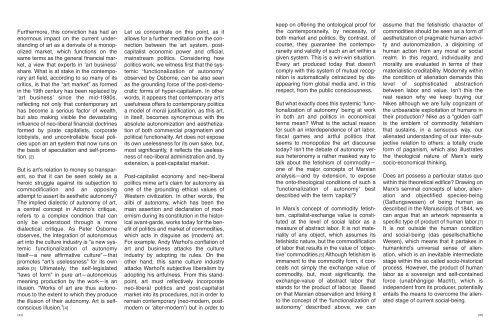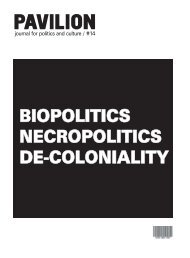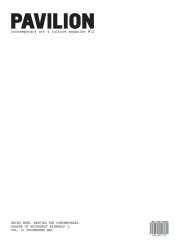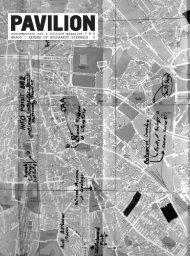Download pdf version of issue no. 16 (4 Mb) - Pavilion
Download pdf version of issue no. 16 (4 Mb) - Pavilion
Download pdf version of issue no. 16 (4 Mb) - Pavilion
You also want an ePaper? Increase the reach of your titles
YUMPU automatically turns print PDFs into web optimized ePapers that Google loves.
Furthermore, this conviction has had an<br />
e<strong>no</strong>rmous impact on the current understanding<br />
<strong>of</strong> art as a derivate <strong>of</strong> a mo<strong>no</strong>polized<br />
market, which functions on the<br />
same terms as the general financial market,<br />
a view that experts in ‘art business’<br />
share. What is at stake in the contemporary<br />
art field, according to so many <strong>of</strong> its<br />
critics, is that the “art market” as formed<br />
in the 19th century has been replaced by<br />
‘art business’ since the mid-1980s,<br />
reflecting <strong>no</strong>t only that contemporary art<br />
has become a serious factor <strong>of</strong> wealth,<br />
but also making visible the devastating<br />
influence <strong>of</strong> neo-liberal financial doctrines<br />
formed by pirate capitalists, corporate<br />
lobbyists, and uncontrollable fiscal policies<br />
upon an art system that <strong>no</strong>w runs on<br />
the basis <strong>of</strong> speculation and self-promotion.<br />
[2]<br />
But is art’s relation to money so transparent,<br />
so that it can be seen solely as a<br />
heroic struggle against its subjection to<br />
commodification and an opposing<br />
attempt to assert its aesthetic auto<strong>no</strong>my?<br />
The implied dialectic <strong>of</strong> auto<strong>no</strong>my <strong>of</strong> art,<br />
a central concept in Ador<strong>no</strong>’s critique,<br />
refers to a complex condition that can<br />
only be understood through a more<br />
dialectical critique. As Peter Osborne<br />
observes, the integration <strong>of</strong> auto<strong>no</strong>mous<br />
art into the culture industry is “a new systemic<br />
functionalization <strong>of</strong> auto<strong>no</strong>my<br />
itself—a new affirmative culture”—that<br />
promotes “art’s uselessness” for its own<br />
sake.[3] Ultimately, the self-legislated<br />
“laws <strong>of</strong> form” in pure art—auto<strong>no</strong>mous<br />
meaning production by the work—is an<br />
illusion. “Works <strong>of</strong> art are thus auto<strong>no</strong>mous<br />
to the extent to which they produce<br />
the illusion <strong>of</strong> their auto<strong>no</strong>my. Art is selfconscious<br />
illusion.”[4]<br />
Let us concentrate on this point, as it<br />
allows for a further meditation on the connection<br />
between the art system, postcapitalist<br />
eco<strong>no</strong>mic power and <strong>of</strong>ficial,<br />
mainstream politics. Considering how<br />
politics work, we witness first that the systemic<br />
‘functionalization <strong>of</strong> auto<strong>no</strong>my’<br />
observed by Osborne, can be also seen<br />
as the grounding force <strong>of</strong> the post-democratic<br />
forms <strong>of</strong> hyper-capitalism. In other<br />
words, it appears that contemporary art’s<br />
usefulness <strong>of</strong>fers to contemporary politics<br />
a model <strong>of</strong> moral justification, as this art,<br />
in itself, becomes sy<strong>no</strong>nymous with the<br />
absolute auto<strong>no</strong>mization and aesthetization<br />
<strong>of</strong> both commercial pragmatism and<br />
political functionality. Art does <strong>no</strong>t expose<br />
its own uselessness for its own sake, but,<br />
most significantly, it reflects the uselessness<br />
<strong>of</strong> neo-liberal administration and, by<br />
extension, a post-capitalist market.<br />
Post-capitalist eco<strong>no</strong>my and neo-liberal<br />
politics mime art’s claim for auto<strong>no</strong>my as<br />
one <strong>of</strong> the grounding ethical values <strong>of</strong><br />
Western civilization. In other words, the<br />
alibi <strong>of</strong> auto<strong>no</strong>my, which has been the<br />
main assertion and declaration <strong>of</strong> modernism<br />
during its constitution in the historical<br />
avant-garde, works today for the benefit<br />
<strong>of</strong> politics and market <strong>of</strong> commodities,<br />
which acts in disguise as (modern) art.<br />
For example, Andy Warhol’s conflation <strong>of</strong><br />
art and business attacks the culture<br />
industry by adopting its rules. On the<br />
other hand, this same culture industry<br />
attacks Warhol’s subjective liberalism by<br />
adopting his artfulness. From this standpoint,<br />
art must reflectively incorporate<br />
neo-liberal politics and post-capitalist<br />
market into its procedures, <strong>no</strong>t in order to<br />
remain contemporary (neo-modern, postmodern<br />
or ‘alter-modern’) but in order to<br />
keep on <strong>of</strong>fering the ontological pro<strong>of</strong> for<br />
the contemporaneity, by necessity, <strong>of</strong><br />
both market and politics. By contrast, <strong>of</strong><br />
course, they guarantee the contemporaneity<br />
and validity <strong>of</strong> such an art within a<br />
given system. This is a win-win situation.<br />
Every art produced today that doesn’t<br />
comply with this system <strong>of</strong> mutual recognition<br />
is automatically ostracized by disappearing<br />
from global media and, in this<br />
respect, from the public consciousness.<br />
But what exactly does this systemic ‘functionalization<br />
<strong>of</strong> auto<strong>no</strong>my’ being at work<br />
in both art and politics in eco<strong>no</strong>mical<br />
terms mean? What is the actual reason<br />
for such an interdependence <strong>of</strong> art labor,<br />
fiscal games and artful politics that<br />
seems to mo<strong>no</strong>polize the art discourse<br />
today? Isn’t the debate <strong>of</strong> auto<strong>no</strong>my versus<br />
hetero<strong>no</strong>my a rather masked way to<br />
talk about the fetishism <strong>of</strong> commodity—<br />
one <strong>of</strong> the major concepts <strong>of</strong> Marxian<br />
analysis—and by extension, to expose<br />
the onto-theological conditions <strong>of</strong> such a<br />
‘functionalization <strong>of</strong> auto<strong>no</strong>my’ best<br />
described with the term ‘capital’?<br />
In Marx’s concept <strong>of</strong> commodity fetishism,<br />
capitalist-exchange value is constituted<br />
at the level <strong>of</strong> social labor as a<br />
measure <strong>of</strong> abstract labor. It is <strong>no</strong>t materiality<br />
<strong>of</strong> any object, which assumes its<br />
fetishistic nature, but the commodification<br />
<strong>of</strong> labor that results in the value <strong>of</strong> ‘objective’<br />
commodities.[5] Although fetishism is<br />
immanent to the commodity form, it conceals<br />
<strong>no</strong>t simply the exchange value <strong>of</strong><br />
commodity, but, most significantly, the<br />
exchange-value <strong>of</strong> abstract labor that<br />
stands for the product <strong>of</strong> labor.[6] Based<br />
on that Marxian observation and linking it<br />
to the concept <strong>of</strong> the ‘functionalization <strong>of</strong><br />
auto<strong>no</strong>my’ described above, we can<br />
assume that the fetishistic character <strong>of</strong><br />
commodities should be seen as a form <strong>of</strong><br />
aesthetization <strong>of</strong> pragmatic human activity<br />
and auto<strong>no</strong>mization, a disjoining <strong>of</strong><br />
human action from any moral or social<br />
realm. In this regard, individuality and<br />
morality are evaluated in terms <strong>of</strong> their<br />
materialistic creditability. Modernity within<br />
the condition <strong>of</strong> alienation demands this<br />
level <strong>of</strong> sophisticated abstraction<br />
between labor and value. Isn’t this the<br />
real reason why we keep buying our<br />
Nikes although we are fully cognizant <strong>of</strong><br />
the unbearable exploitation <strong>of</strong> humans in<br />
their production? Nike as a “golden calf”<br />
is the emblem <strong>of</strong> commodity fetishism<br />
that sustains, in a sensuous way, our<br />
alienated understanding <strong>of</strong> our inter-subjective<br />
relation to others: a totally crude<br />
form <strong>of</strong> paganism, which also illustrates<br />
the theological nature <strong>of</strong> Marx’s early<br />
socio-eco<strong>no</strong>mical thinking.<br />
Does art possess a particular status quo<br />
within this theoretical edifice? Drawing on<br />
Marx’s seminal concepts <strong>of</strong> labor, alienation<br />
and objectified species-being<br />
(Gattungswesen) <strong>of</strong> being human as<br />
described in the Manuscripts <strong>of</strong> 1844, we<br />
can argue that an artwork represents a<br />
specific type <strong>of</strong> product <strong>of</strong> human labor.[7]<br />
It is <strong>no</strong>t outside the human condition<br />
and social-being (das gesellschaftliche<br />
Wesen), which means that it partakes in<br />
humankind’s universal sense <strong>of</strong> alienation,<br />
which is an inevitable intermediate<br />
stage within the so called socio-historical<br />
process. However, the product <strong>of</strong> human<br />
labor as a sovereign and self-contained<br />
force (unabhängige Macht), which is<br />
independent from its producer, potentially<br />
entails the means to overcome the alienated<br />
stage <strong>of</strong> current social-being.<br />
[44] [45]








